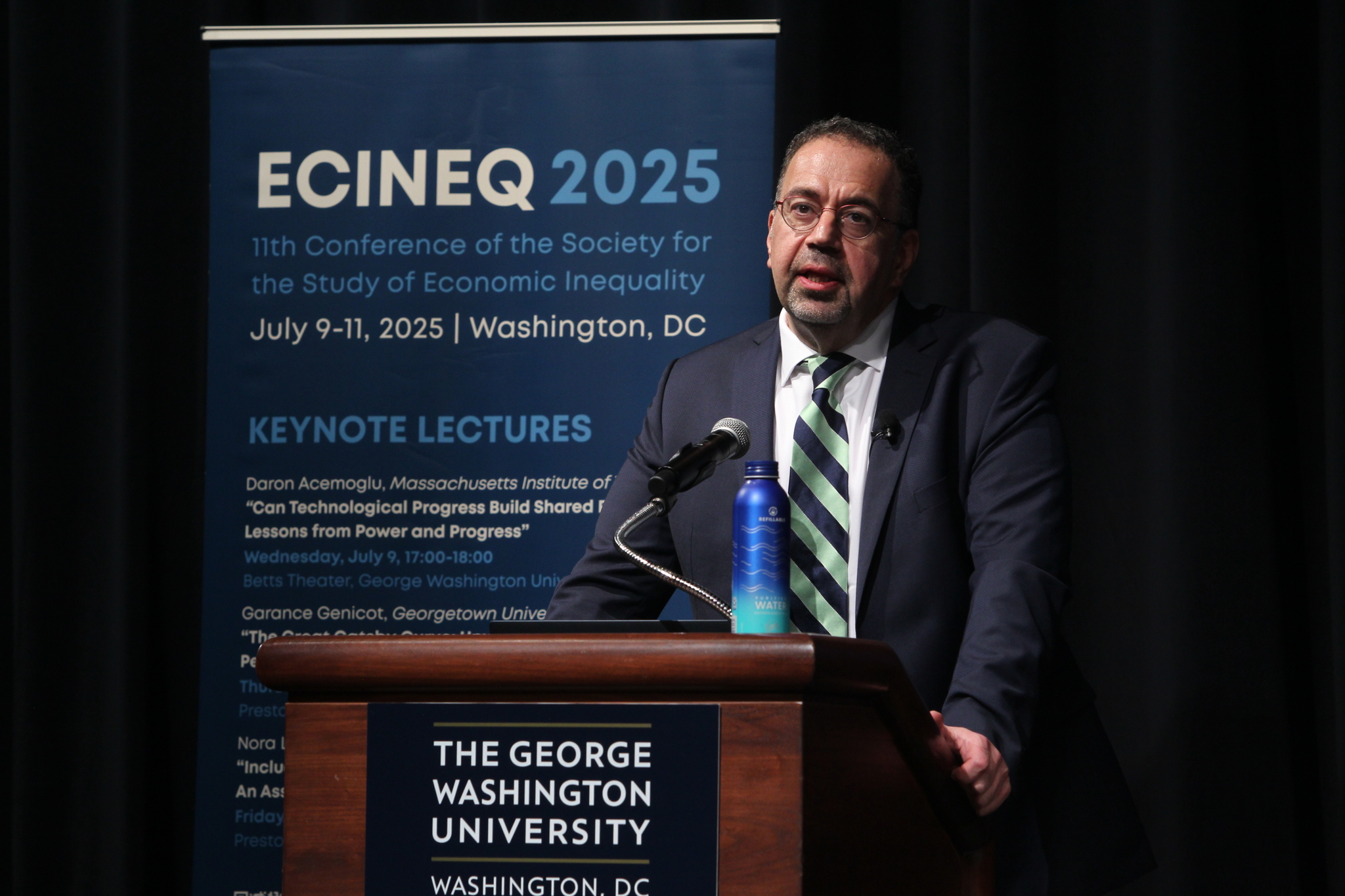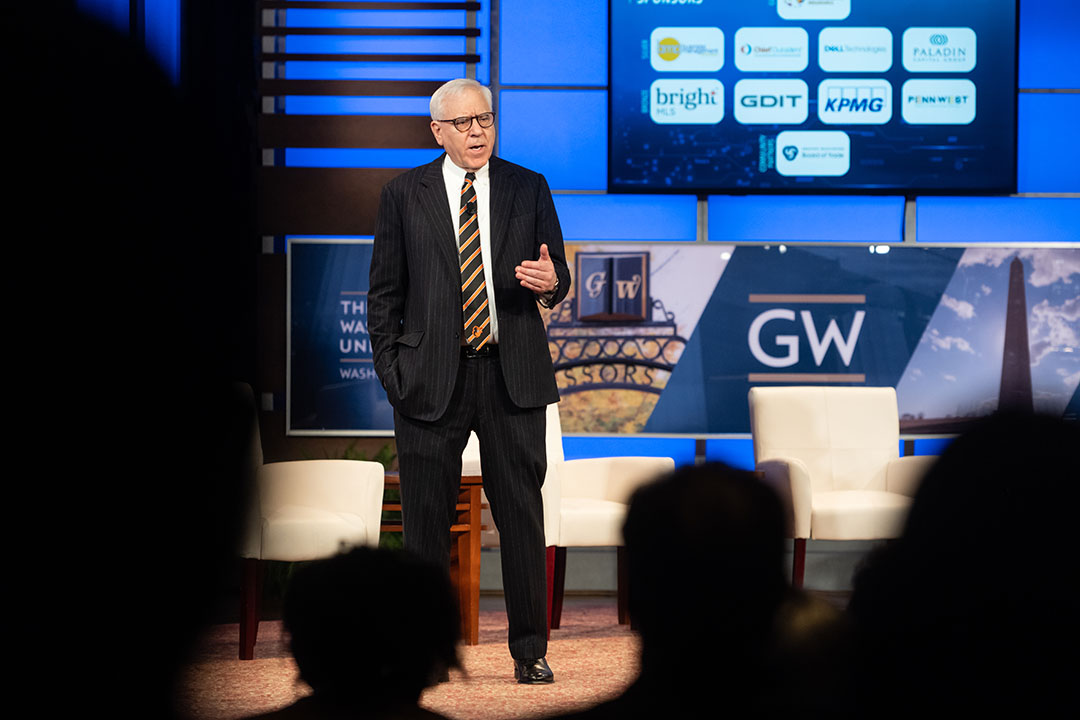The Institute for International Economic Policy (IIEP) at the George Washington University Elliott School of International Affairs hosted Daron Acemoglu, a renowned economist and the 2024 Nobel Laureate in Economic Sciences, for a keynote address.
The presentation, titled “Can Technological Progress Build Shared Prosperity? Lessons from Power and Progress,” was held at the University Student Center and was part of the 11th conference of The Society for the Study of Economic Inequality (ECINEQ). It was the only public session of the conference and the only one held outside of the World Bank headquarters.
The event drew scholars, policymakers and students interested in the intersection of economics, technology and equity as part of IIEP’s Yunus Initiative on Extreme Deprivation.
Nora Lustig, founding director of the Commitment to Equity Institute (CEQ) at Tulane University and president of ECINEQ, opened the event by acknowledging the support of the conference organizers and event partners, including the World Bank, GW and IIEP. Lustig was formerly the J.B. and Maurice C. Shapiro Visiting Professor of International Affairs at GW and an IIEP faculty affiliate.
She introduced Acemoglu, highlighting his far-reaching impact on the field of economics.
“Professor Acemoglu is widely recognized as one of the most influential economists of our time,” Lustig said. “He has profoundly shaped our understanding of how political and economic institutions affect development and how automation and artificial intelligence are reshaping labor markets and democratic governance.”
Acemoglu said he believes issues of inequality are always intertwined with choices about technology, as he reflected on the question of whether technological progress will be consistent with shared prosperity.
“By many measures, we live in an age of innovation. We are surrounded by new gadgets, new services, new apps every day and, according to most measures of innovation, there has been a marked explosion,” Acemoglu said.
He explained that technological progress does not automatically lead to shared prosperity. Instead, the benefits of innovation depend on how it is used and the values and institutions that shape its direction.
Acemoglu used the Industrial Revolution to illustrate how technological advances aren’t guaranteed to improve inequality. In the early stages of the British Industrial Revolution, the introduction of machinery displaced workers, causing wages to fall by nearly two-thirds and a significant deterioration in working conditions.
“This is important because sometimes we are told [that] worries about AI or other technologies that could be revolutionary becoming engines of inequality are overblown because the Industrial Revolution shows that in the end everybody benefits,” Acemoglu said. “Well, what's often glossed over in those accounts is that it took about 100 years, more than three generations.”
He explored how that history compares to what’s been seen in modern times.
“Well, there is a sense in which modern times are different, and there is a sense in which modern times are actually showing strange parallels,” Acemoglu said.
After World War II, the United States and other industrialized nations experienced a period of shared prosperity, marked by rapid productivity and wage growth across all demographic groups. Wages rose even faster than productivity, particularly for women and less-educated workers in the 1950s and 60s.
However, around 1980, this pattern changed. Wages began to diverge based on education level. Highly educated workers saw continued wage growth, while those with only a high school diploma or less experienced a steady decline in real wages over the next 30 years. This shift represents a break from the earlier era of broadly shared gains.
“So in some sense, modern times are different because we've had this experience of shared prosperity with rapid technological progress, but they're also repeating some of the patterns that we saw during the Industrial Revolution,” Acemoglu said. “So if we want to answer the question of when and how technology can be consistent with shared prosperity, we want to understand how it was that that period of shared prosperity was built, what were the institutional and technological preconditions to it, and why it came apart.”
He said while digital technologies have impacted all industrialized countries in similar ways, such as replacing blue-collar and office jobs, the outcomes vary across nations due to differences in institutions and choices.
He explained how institutional choices made in the United States led to significant job losses among manual workers and increased wage disparities.
Starting in the late 1970s and early 1980s, automation in industries like auto manufacturing saw manual workers get replaced by fewer, highly skilled workers who programmed and oversaw machines. Also, during that time, business priorities shifted toward aggressive cost-cutting, influenced in part by thinkers like Milton Friedman, who famously argued that a company’s only social responsibility is to increase profits.
At the same time, labor unions, once a force that could push back against these trends, were weakened by anti-union policies, including those under the Reagan administration. As a result, new digital tools were largely developed and used to replace workers, rather than to support or empower them.
“So if you want to understand inequality in the United States, it's all about automation. But it's not just about automation, and moreover, automation itself is not a force of nature. It's an endogenous choice that companies make,” Acemoglu said.
Relating to AI, Acemoglu said there’s a school of thought that envisions machines being designed to replicate human intelligence and eventually take over human tasks.
But there’s another school of thought, dating back to early computing pioneers like Joseph Carl Robnett Licklider and Douglas Engelbart, that views technology as a means to extend human capabilities rather than replace them. This approach imagined digital tools as partners to workers, designed to help people do more, learn more and work more effectively.
“So if you can leverage AI to be complementary to workers—to be pro-worker—I think it greatly expands our ability to make progress,” Acemoglu said. “In particular, in areas that are so important to the economy and where we face major bottlenecks—like education, healthcare and other essential services—we sorely need productivity growth. And that’s about creating new services and new organizations, and I think that’s where AI can help.”
Acemoglu argued that returning to this more human-centered, pro-worker approach is critical, especially now, as AI becomes more powerful and influential.





